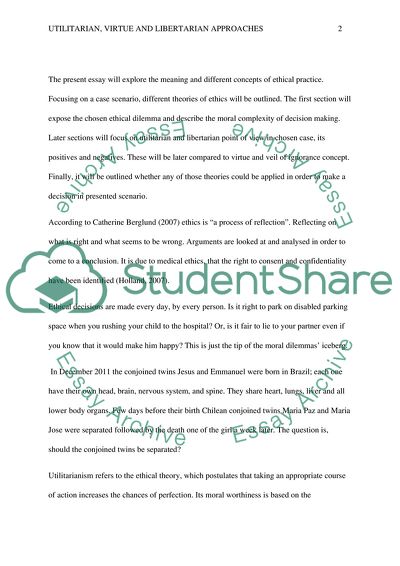Cite this document
(Utilitarian, Virtue and Libertarian Approaches to Conjoined Twins Case Essay Example | Topics and Well Written Essays - 1250 words - 1, n.d.)
Utilitarian, Virtue and Libertarian Approaches to Conjoined Twins Case Essay Example | Topics and Well Written Essays - 1250 words - 1. https://studentshare.org/philosophy/1793524-ethical-dilemma-analysing-the-dilemma-using-different-ethical-theories-utilitarianizm-liberty-virtue
Utilitarian, Virtue and Libertarian Approaches to Conjoined Twins Case Essay Example | Topics and Well Written Essays - 1250 words - 1. https://studentshare.org/philosophy/1793524-ethical-dilemma-analysing-the-dilemma-using-different-ethical-theories-utilitarianizm-liberty-virtue
(Utilitarian, Virtue and Libertarian Approaches to Conjoined Twins Case Essay Example | Topics and Well Written Essays - 1250 Words - 1)
Utilitarian, Virtue and Libertarian Approaches to Conjoined Twins Case Essay Example | Topics and Well Written Essays - 1250 Words - 1. https://studentshare.org/philosophy/1793524-ethical-dilemma-analysing-the-dilemma-using-different-ethical-theories-utilitarianizm-liberty-virtue.
Utilitarian, Virtue and Libertarian Approaches to Conjoined Twins Case Essay Example | Topics and Well Written Essays - 1250 Words - 1. https://studentshare.org/philosophy/1793524-ethical-dilemma-analysing-the-dilemma-using-different-ethical-theories-utilitarianizm-liberty-virtue.
“Utilitarian, Virtue and Libertarian Approaches to Conjoined Twins Case Essay Example | Topics and Well Written Essays - 1250 Words - 1”. https://studentshare.org/philosophy/1793524-ethical-dilemma-analysing-the-dilemma-using-different-ethical-theories-utilitarianizm-liberty-virtue.


